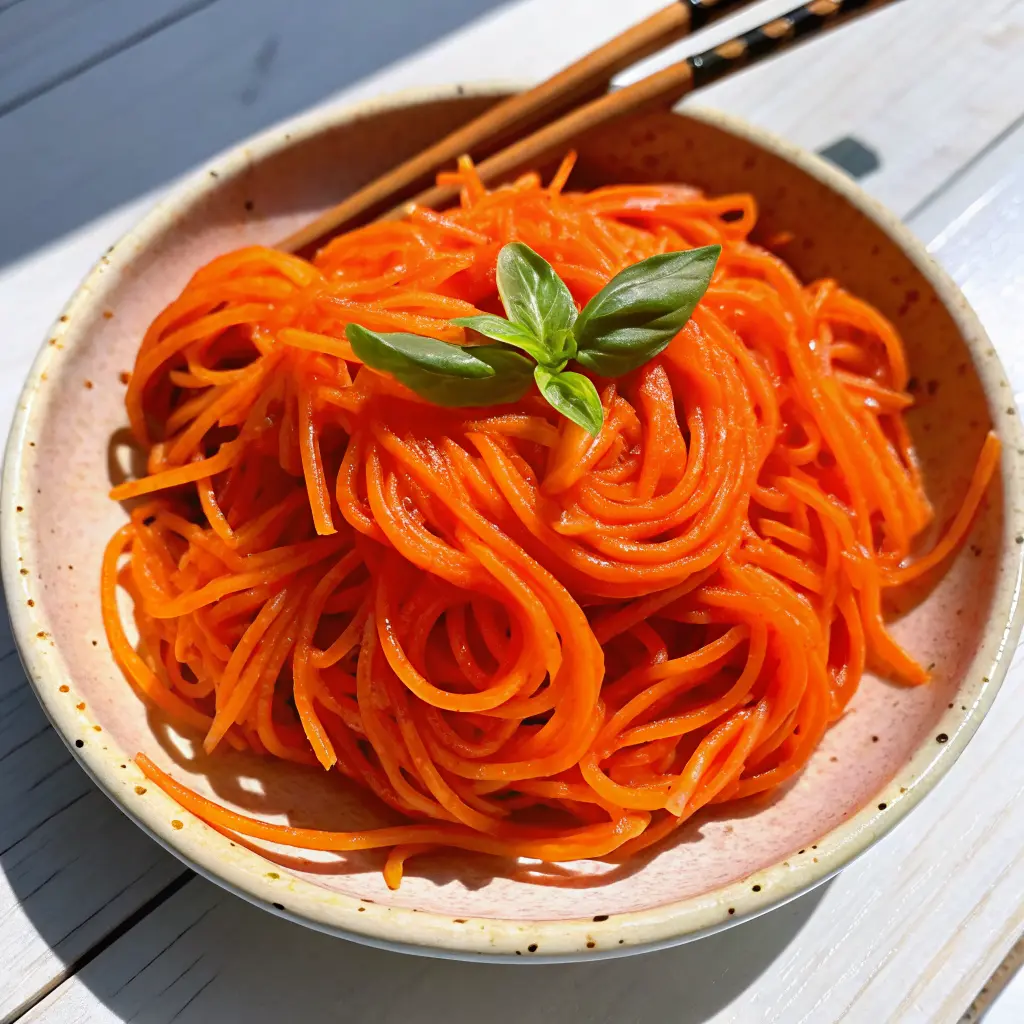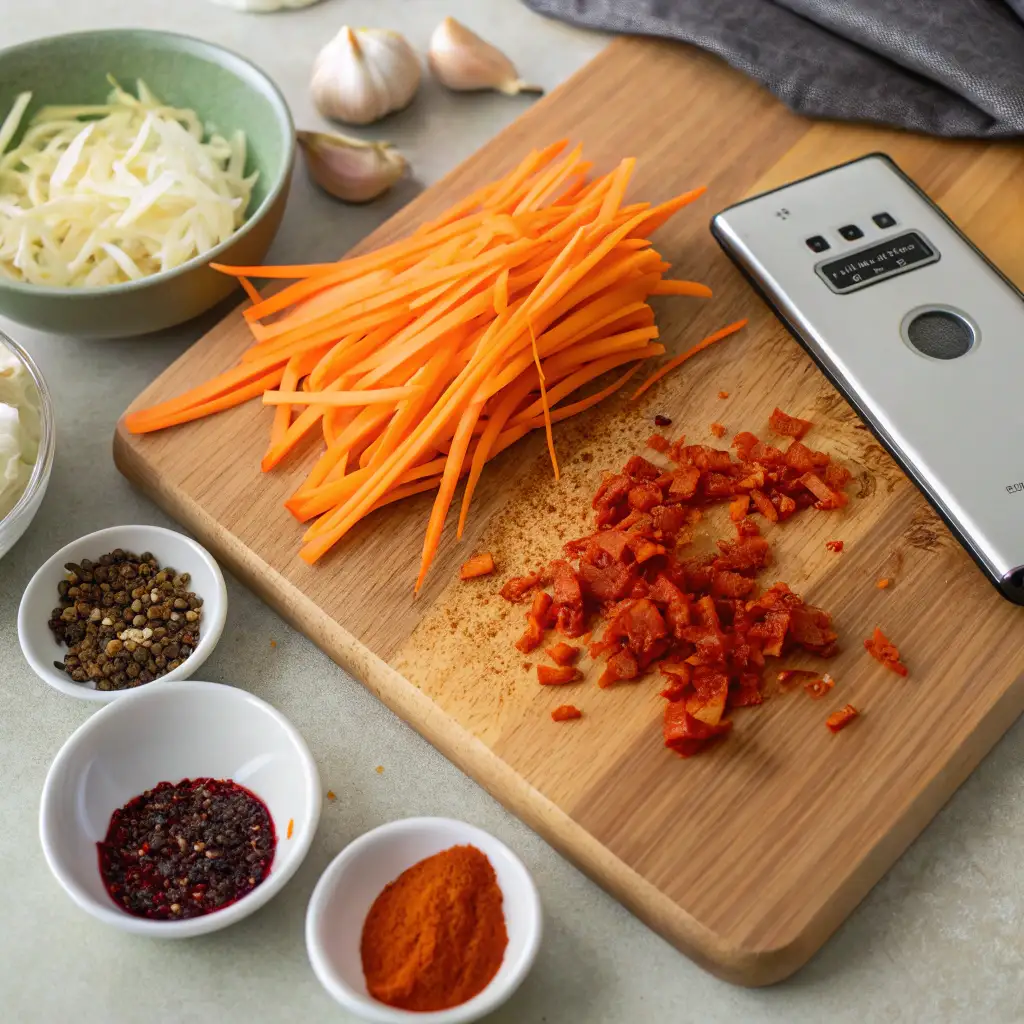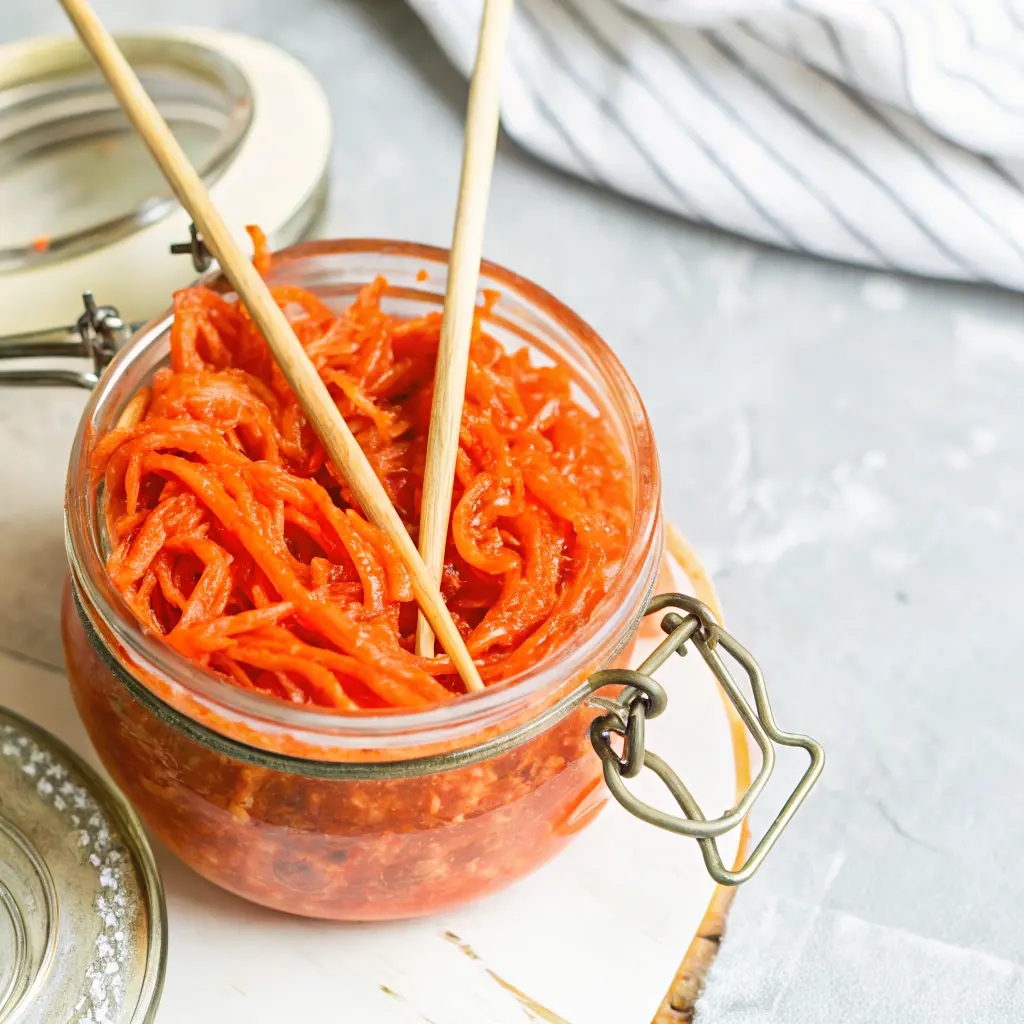Korean carrot salad is a tangy, crunchy, and colorful dish that instantly livens up any plate. Also known as Morkovcha, this vibrant side is made with julienned carrots tossed in a zesty garlic and vinegar dressing. It’s quick to make with simple pantry ingredients and works beautifully at picnics, barbecues, or everyday meals.
I wasn’t always a fan of carrots—until this spicy carrot salad changed my mind. Even skeptics will be hooked after one bite.
Check out this Mounjaro drink hack guide for a bold flavor combo to enjoy alongside this refreshing Korean carrot salad.
Table of Contents
What is Korean Carrot Salad (Morkovcha)?
Often referred to as Morkovcha (Морковча) in post-Soviet countries, this dish was created by the Koryo-saram, or ethnic Koreans in Central Asia. They adapted traditional kimchi recipes using carrots in place of harder-to-find ingredients like Napa cabbage.
This Korean-style carrot side became widely popular during the Soviet era. Thinly sliced strips marinated in a tangy, garlic-forward dressing were not only easy to make but also budget-friendly.
Don’t miss our butterfly pea flower tea recipe—a colorful drink that pairs beautifully with the tang and crunch of this salad.
More than just a salad, it’s a flavorful fusion of cultures and traditions, honoring both Korean and Russian influences.
PrintKorean Carrot Salad: A Tangy and Crunchy Delight
Korean Carrot Salad, or Morkovcha, is a vibrant, tangy slaw made with julienned carrots, garlic, and vinegar. This crunchy side dish is quick to make and brings bold flavor to any table.
- Prep Time: 15 minutes
- Cook Time: 5 minutes
- Total Time: 20 minutes
- Yield: 6 servings 1x
- Category: Side Dish
- Method: No-Cook
- Cuisine: Korean-Inspired
Ingredients
- 1 lb carrots, peeled and julienned
- 1 tsp kosher salt
- 1½ tbsp sugar
- 2 tbsp white vinegar
- ½ tbsp gochugaru (or ¼ tsp cayenne + 1 tsp paprika)
- 3 tbsp oil (canola or vegetable)
- 1 tbsp minced garlic
Instructions
- Peel and julienne the carrots using a mandolin or sharp knife.
- Place in a large bowl, toss with kosher salt, and let sit for 10 minutes to soften.
- Add sugar, white vinegar, and gochugaru (or its substitute) to the carrots and mix well.
- In a small saucepan, heat oil and sauté minced garlic until aromatic.
- Pour hot garlic oil over the carrot mixture and toss to combine thoroughly.
- Serve immediately or chill for 1–2 hours for deeper flavor.
Notes
For best results, use a julienne peeler or mandolin. Gochugaru adds color and mild heat, but paprika and cayenne can be used as substitutes. Stick to light-colored vinegar for a vibrant appearance.
Nutrition
- Serving Size: 1 portion
- Calories: 120
- Sugar: 5g
- Sodium: 300mg
- Fat: 7g
- Saturated Fat: 1g
- Unsaturated Fat: 6g
- Trans Fat: 0g
- Carbohydrates: 13g
- Fiber: 3g
- Protein: 1g
- Cholesterol: 0mg

How to Make Korean Carrot Salad
To make this flavorful slaw, peel and julienne one pound of carrots using a mandolin or sharp knife. Place them in a large bowl and toss with a teaspoon of kosher salt. Let the carrots soften slightly—about 10 minutes.
Then, mix in 1½ tablespoons sugar, 2 tablespoons white vinegar, and ½ tablespoon gochugaru (Korean chili flakes). No gochugaru? A mix of cayenne pepper and paprika will work too.
In a small saucepan, heat 3 tablespoons of oil and sauté a tablespoon of minced garlic until aromatic. Pour this hot garlic oil over the carrots and mix well. Serve immediately or chill for 1–2 hours to let the flavors meld.
What to Serve with Korean Carrot Salad
This bright side pairs incredibly well with grilled meats, roasted fish, or even in sandwiches. Think pork belly, grilled mackerel, or savory wraps—it’s the tangy bite that balances out bold flavors.
Discover great ideas like this matcha pan creation if you want to round out your meal with a lightly sweet and earthy finish.
It’s a go-to for BBQs, potlucks, or even lunchbox additions. Bonus: it travels well and looks great in a mason jar.
Tips for the Best Korean Carrot Salad
For best texture, use a julienne peeler or mandolin slicer to cut the carrots into uniform strips. Avoid a grater if possible—it can make the salad mushy.
Want a bit of kick? Gochugaru offers both color and mild heat, but you can sub it with paprika and cayenne for similar depth. Sprinkle in coriander or cardamom for added aroma.
Stick to white vinegar, rice vinegar, or white wine vinegar to keep that bold orange color. Darker vinegars like balsamic overpower the flavor and dull the appearance.

Ingredients Summary
| Ingredient | Quantity |
|---|---|
| Carrots | 1 lb |
| Kosher Salt | 1 tsp |
| Sugar | 1½ tbsp |
| White Vinegar | 2 tbsp |
| Gochugaru/Substitute | ½ tbsp or ¼ tsp cayenne + 1 tsp paprika |
| Oil | 3 tbsp |
| Minced Garlic | 1 tbsp |
This recipe makes 6 servings and can be stored in the refrigerator for up to one week. It’s a practical addition to any weekly meal prep.
Conclusion
Korean carrot salad is much more than a simple vegetable side—it’s a story of adaptation, culture, and culinary brilliance. Whether you’re enjoying it at a picnic, next to grilled meat, or on its own, this tangy, crunchy dish adds flair to any plate. It’s quick to prepare, full of flavor, and absolutely addictive. If you haven’t tried korean carrot salad yet, now is the perfect time to discover why it’s so beloved across continents.
Frequently Asked Questions
What is a Korean Carrot Salad called?
The dish is commonly called Morkovcha, which means “Korean-style carrots” in Russian. It’s a fusion recipe developed by ethnic Koreans in Central Asia, combining elements of kimchi and Russian cuisine.
Is morkovcha fermented?
No. Unlike traditional kimchi, Morkovcha is not fermented. It is simply marinated and can be served within hours, making it quick and convenient.
What oil to use for Korean Carrot Salad?
Use a neutral oil like canola, sunflower, or vegetable oil. These won’t interfere with the flavor of the marinade. Avoid olive or sesame oil for this dish.
Is a raw carrot salad good for you?
Yes! Carrots are rich in vitamins A and K, fiber, and antioxidants. This salad delivers crunch and flavor with minimal fat, making it a healthy, low-calorie side dish.


